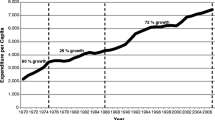Abstract
In this paper I use data from the Panel Study on Income Dynamics to examine the relationship between the dependent exemption feature of the United States federal income tax (an unambiguous subsidy to dependents) and the fertility behavior of married couples over the period 1979–1983. The exemption decreases the price of a child to a household, thus having a direct relationship to the timing and/or number of children observed in a family. Conditional logit results support this hypothesis by showing that the exemption has a positive and significant impact on the likelihood of having a birth during the period under study.
Similar content being viewed by others
References
Aaron, Henry J. and Joseph A. Pechman (eds.). 1981. How Taxes Affect Economic Behavior. Washington, DC: Brookings Institution.
Averett, Susan L. 1991. “Child Care Costs and Female Labor Supply: An Empirical Investigation of the Effects of the Child Care Tax Credit on Female Labor Supply and Demand for Child Care.” Doctoral dissertation, University of Colorado.
Becker, Gary. 1960. “An Economic Analysis of Fertility.” Pp. 209–31 in Demographic and Economic Change in Developed Countries, edited by Universities-National Bureau Committee for Economic Research. Princeton: Princeton University Press.
Becker, Gary S. and H. Gregg Lewis. 1976. “On the Interaction between the Quantity and Quality of Children.” Pp. 195–204, in The Economic Approach to Human Behavior, edited by Gary S. Becker. Chicago: University of Chicago Press.
Becketti, Sean, William Gould, Lee Lillard, and Finis Welch. 1988. “The Panel Study of Income Dynamics after Fourteen Years: An Evaluation.” Journal of Labor Economics 6(4):472–92.
Blau, David M. and Philip K. Robins. 1989. “Fertility, Employment and Child-Care Costs.” Demography 26(4):287–99.
—. 1991. “Child Care Demand and Labor Supply of Young Mothers over Time.” Demography 28(3):333–51.
Bloom, David E. 1982. “What’s Happening to the Age at First Birth in the United States? A Study of Recent Cohorts.” Demography 19(3):351–70.
Borg, Mary O’Malley. 1989. “The Income-Fertility Relationship: Effect of the Net Price of a Child.” Demography 26(2):301–10.
Buttner, Thomas and Wolfgang Lutz. 1990. “Estimating Fertility Responses to Policy Measures in the German Democratic Republic.” Population and Development Review 16(1):539–55.
Cain, Glen C. and Martin D. Dooley. 1976. “Estimation of a Model of Labor Supply, Fertility and Wages of Married Women.” Journal of Political Economy 84(4):S179–99.
Chamberlain, Gary. 1980. “Analysis of Covariance with Qualitative Data.” Review of Economic Studies 47:225–38.
Clotfelter, C. T. and C. E. Steurle. 1981. “Charitable Contributions.” pp. 403–46 in How Taxes Affect Economic Behavior, edited by Henry J. Aaron and Joseph A. Pechman. Washington, DC: Brookings Institution.
Cogan, John. 1981. “Fixed Costs and Labor Supply.” Econometrica 49:945–64.
Espenshade, Thomas J. and Joseph J. Minarik. 1987. “Demographic Implications of the 1986 U.S. Tax Reform.” Population and Development Review 13:115–27.
Greene, William H. 1990. Econometric Analysis. New York: Macmillan.
Hanoch, Giora. 1980. “A Multivariate Model of Labor Supply: Methodology and Estimation.” Pp. 249–326 in Female Labor Supply, edited by James P. Smith. Princeton: Princeton University Press.
Happel, S. K., J. K. Hill, and S. A. Low. 1984. “An Economic Analysis of the Timing of Childbirth.” Population Studies 38:299–311.
Hausman, Jerry A. and James Poterba. 1987. “Household Behavior and the Tax Reform Act of 1986.” Journal of Economic Perspectives 1:110–19.
Heckman, James. 1980. “Sample Selection Bias as a Specification Error with an Application to the Estimation of Labor Supply Functions.” Pp. 206–48 in Female Labor Supply, edited by James P. Smith. Princeton: Princeton University Press.
Heckman, James J., V. Joseph Hotz, and James R. Walker. 1985. “New Evidence on the Timing and Spacing of Births.” American Economic Review 75(2): 179–84.
Kelly, Cindy. 1991. “Tax Changes May Spawn New Baby Boom.” The Margin 7 (Fall):50.
Lindert, Peter H. 1978. Fertility and Scarcity in America. Princeton: Princeton University Press.
Michael, Robert T. 1985. “Consequences of the Rise in Female Labor Force Participation Rates: Questions and Probes.” Journal of Labor Economics, 3(1):S117–47.
Moynihan, Daniel P. 1986. Fertility and Nation: The God kin Lectures, Harvard University. New York: Harcourt, Brace, and Jovanovich.
Olsen, Randall J. and Kenneth I. Wolpin. 1983. “The Impact of Exogenous Child Mortality on Fertility: A Waiting Time Regression with Dynamic Regressors.” Econometrica 51 (3):731–49.
Pitt, Mark M. and Mark R. Rosenzweig. 1990. “Estimating the Intrahousehold Incidence of Illness: Child Health and Gender-Inequality in the Allocation of Time.” International Economic Review 31(4):969–89.
Schultz, T. Paul. 1973. “A Preliminary Survey of Economic Analyses of Fertility.” American Economic Review 63:71–87.
—. 1981. Economics of Population. Reading. MA: Addison-Wesley.
“That Sinking Feeling.” 1991. Newsweek. November 4. pp. 18–21.
Whittington, Leslie. 1989. “Taxes and the Family: The Personal Exemption and Fertility in the United States.” Doctoral Dissertation, University of Colorado.
Whittington. Leslie, James Aim, and H. Elizabeth Peters. 1990. “The Personal Exemption and Fertility: Implicit Pronatalist Policy in the U.S.” American Economic Review 80(2):545–56.
Willis, Robert J. 1974. “Economic Theory of Fertility Behavior.” Pp. 25–75 in Economics of the Family, edited by Theodore W. Schultz. Chicago: University of Chicago Press.
Author information
Authors and Affiliations
Additional information
I am grateful to Jim Aim, Eric Jensen, Joan Kahn, Ron Lee, David Merriman, Elizabeth Peters, David Stapleton, Glen Sueyoshi, and Donald M. Waldman for their helpful comments. I am indebted to Alice J. O’Dea for her skillful word processing assistance.
Rights and permissions
About this article
Cite this article
Whittington, L.A. Taxes and the Family: The impact of the tax exemption for dependents on marital fertility. Demography 29, 215–226 (1992). https://doi.org/10.2307/2061728
Issue Date:
DOI: https://doi.org/10.2307/2061728




